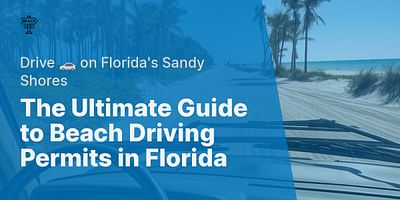Kurtis is a seasoned former law enforcement officer, whose career was spent safeguarding the coastal areas. His current mission is to utilize his wealth of knowledge to inform others about the essentials of safe beach driving.
Answer:
No, beach driving laws are not the same in every state. Each state has its own set of regulations and rules when it comes to driving on the beach. It's important to familiarize yourself with the specific laws of the state you plan to visit to ensure you are driving legally and safely.
In the United States, beach driving is a popular activity for many beachgoers. However, it's crucial to understand that the rules and regulations surrounding beach driving can vary from state to state. This means that what may be allowed in one state may not be permitted in another.
Why do beach driving laws differ?
The reason for the variation in beach driving laws is that each state has different environmental concerns, wildlife preservation efforts, and public safety considerations. These factors influence the regulations put in place to protect the beach ecosystem and ensure the safety of both drivers and pedestrians.
For example, some states may have restrictions on certain areas of the beach to protect nesting sea turtles or endangered bird species. Others may have speed limits in place to prevent accidents and minimize the impact on the beach environment.
How can I find the beach driving laws for a specific state?
To find the beach driving laws for a specific state, it's best to consult the official website of the state's Department of Natural Resources or Department of Environmental Protection. These websites typically provide detailed information on beach driving regulations, permit requirements, and any specific rules that must be followed.
Additionally, you can also reach out to local beach authorities or visitor centers for up-to-date information on beach driving laws. They can provide you with the most accurate and current information regarding the rules and regulations specific to the area you plan to visit.
What are some common beach driving regulations?
While the specific regulations may vary, there are some common beach driving rules that are often enforced across different states. These include:
1. Permit requirements: Many states require a beach driving permit, which can be obtained from the appropriate authorities. It's important to check if a permit is required and obtain one before driving on the beach.
2. Designated driving areas: Most states have designated areas where beach driving is allowed. It's important to stay within these designated zones and avoid driving in restricted or protected areas.
3. Speed limits: Speed limits are often enforced on the beach to ensure the safety of all beachgoers. It's important to adhere to the posted speed limits and drive at a safe and reasonable speed.
4. Wildlife protection: Many beaches are home to various wildlife species, such as nesting sea turtles or birds. It's important to respect these animals and follow any regulations in place to protect their habitats.
5. Beach access points: Some beaches have specific access points for vehicles. It's important to use these designated entry and exit points and avoid driving on dunes or sensitive vegetation.
Remember, it's crucial to familiarize yourself with the specific regulations of the state you plan to visit to ensure you are driving legally and responsibly. Ignorance of the laws is not an excuse, and violating beach driving regulations can result in fines, penalties, or even the revocation of driving privileges.
In conclusion, beach driving laws are not the same in every state. Each state has its own set of regulations and rules to protect the beach environment and ensure the safety of all beachgoers. It's important to research and understand the specific laws of the state you plan to visit to have a safe and enjoyable beach driving experience.















